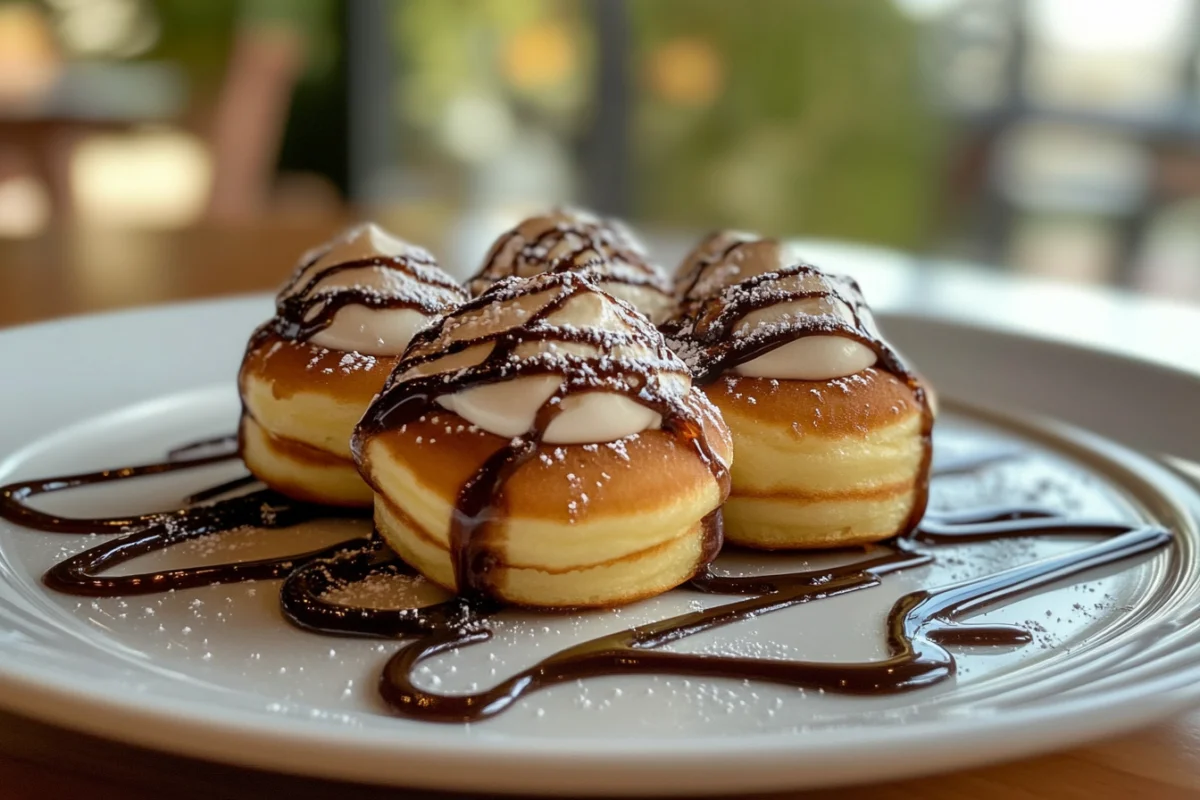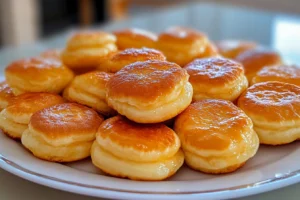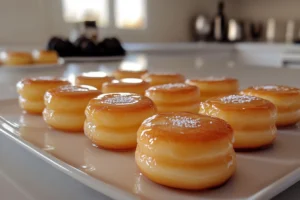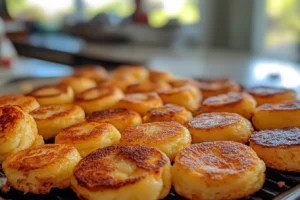Introduction to Fluffy Pancakes
Restaurant pancakes have a reputation for being light, fluffy, and delicious, standing out from the standard homemade versions many of us are accustomed to. Whether it’s the perfect stack at a diner or those golden pancakes at a chain restaurant like IHOP, there’s something about the texture and flavor that makes them unforgettable. But what’s the secret? Why do pancakes at restaurants taste so much better and look so fluffy?
In this article, we’ll explore the science, ingredients, and techniques that contribute to the fluffiness of restaurant pancakes. From buttermilk to special techniques, there’s much more that goes into those perfect pancakes than meets the eye. Let’s dive into the factors that make restaurant pancakes stand out, and how they differ from homemade ones.
If you’re curious about other foods that use similar methods, you might want to check out our article on Corn Nuggets: A Guide, Recipes, Variations, and Benefits. Like pancakes, corn nuggets rely on leavening agents for their crispy texture.
Key Ingredients That Make Pancakes Fluffy
Flour Types and Their Impact on Texture
Flour plays a crucial role in determining the texture of your pancakes. The protein content in flour influences the amount of gluten formed, which in turn affects the texture. For fluffier pancakes, it’s essential to use the right type of flour.
- All-purpose flour is commonly used in pancake recipes, but it’s not always the best option for fluffiness.
- Cake flour, which has less protein than all-purpose flour, helps to produce a more tender and fluffy texture. This is one of the key reasons why pancakes in restaurants are often softer and lighter.
Leavening Agents: Baking Powder and Baking Soda
Leavening agents like baking powder and baking soda are essential to making pancakes rise and become fluffy.
- Baking powder contains both an acid and a base, which react to produce carbon dioxide. This creates air pockets in the batter, making it rise and become fluffy.
- Baking soda is often used in conjunction with buttermilk because the acid in buttermilk reacts with baking soda to release gas, further contributing to a light and airy pancake texture.
Buttermilk vs Regular Milk
Buttermilk is a common ingredient in restaurant pancakes, and for good reason. The acidity in buttermilk reacts with the baking soda to create a fluffier pancake.
- Buttermilk pancakes have a tangy flavor that adds depth to the pancakes, while also making the texture fluffier and moist.
- Using regular milk will give you a denser pancake, as it doesn’t provide the same chemical reaction with the leavening agents.
Eggs: Binding and Fluffing
Eggs are a vital ingredient in pancake batter. They bind the ingredients together and provide structure. But their role doesn’t stop there.
- The whites of eggs trap air during mixing, which helps the pancakes rise during cooking.
- Egg yolks contribute to the texture and flavor, giving the pancakes richness and moisture.
Butter vs Oil: Does it Matter?
While both butter and oil can be used in pancake batter, they impact the fluffiness and flavor of the pancakes in different ways.
- Butter adds richness and flavor to the pancakes but can also make them slightly denser.
- Oil, on the other hand, is often used in restaurant pancake recipes to achieve a slightly lighter texture while still maintaining moisture.
Restaurant Techniques for Making Fluffy Pancakes
Mixing Methods: Over-mixing vs Under-mixing
How you mix your pancake batter can make or break the fluffiness. One common mistake at home is over-mixing the batter, which leads to tough pancakes.
- Over-mixing can develop too much gluten, resulting in dense, flat pancakes.
- Under-mixing, however, is a technique often used in restaurants to keep the batter lumpy, as this prevents overworking the gluten. Lumpy batter creates pancakes that are lighter and fluffier.
The Role of Resting the Batter
Letting pancake batter rest before cooking is another crucial restaurant technique. This step allows the flour to hydrate fully and gives the leavening agents time to activate.
- When the batter rests for 15–30 minutes, the pancakes become airier and fluffier.
- This process also helps to prevent overmixing, as the batter becomes thicker after resting and requires less handling.
The Temperature of the Pan
Restaurants carefully control the temperature of their griddles or pans to cook pancakes perfectly. Too hot, and the pancakes will burn on the outside while remaining raw inside. Too cool, and they won’t rise properly.
- A medium-high temperature is typically ideal for pancakes. It allows the batter to rise while also forming a crisp, golden exterior.
- Many restaurants use professional griddles that maintain even heat, ensuring every pancake is cooked uniformly.
Cooking in Large Batches: Advantages and Disadvantages
Many restaurants cook pancakes in large batches to serve customers quickly. While this can be convenient, it also allows the pancakes to rise more evenly and consistently.
- Large batch cooking ensures that the batter doesn’t lose its rise between pancakes.
- While this technique produces excellent results, it requires a skilled chef to manage heat and timing effectively.
Use of Specialty Tools
Some restaurants use specific tools to enhance the fluffiness of their pancakes. Professional-grade equipment like pancake batter dispensers and griddles help ensure uniform cooking.
- The right pancake griddle ensures even cooking, helping to achieve a consistent texture and even rise.
- Batter dispensers ensure consistent portion sizes, which also contribute to uniform fluffiness across pancakes.
Special Ingredients That Boost Fluffiness
Malted Milk Powder
One of the lesser-known ingredients used in restaurant pancakes is malted milk powder. While it may sound unusual, it is a secret ingredient in many diner-style pancakes, adding a unique flavor and contributing to their fluffiness.
- Malted milk powder contains malted barley, which helps improve both the texture and flavor of the pancakes.
- It gives pancakes a slightly sweet, nutty flavor, and makes the texture lighter and more moist.
- Many diners and restaurants use this ingredient to enhance the overall taste and fluffiness of their pancakes.
Vanilla Extract and Other Flavor Enhancers
Vanilla extract and other flavor enhancers like cinnamon or nutmeg may not directly affect the fluffiness, but they play a vital role in rounding out the pancake’s flavor, making them taste more indulgent.
- Vanilla extract adds a rich, aromatic sweetness that balances the slight tang of buttermilk or yogurt, making the pancakes more flavorful and memorable.
- Subtle additions like cinnamon or nutmeg can also add depth to the flavor, further enhancing the overall eating experience.
Sugar and Salt’s Role
While sugar and salt may seem like simple flavoring agents, they have an important impact on the texture of pancakes, too.
- Sugar helps to caramelize the pancakes as they cook, contributing to a golden, crispy exterior while keeping the interior moist and fluffy.
- Salt, though in smaller quantities, acts as a flavor enhancer, balancing out the sweetness and making the pancake’s fluffiness more pronounced.
Yogurt or Sour Cream: Adding Tang and Moisture
Yogurt or sour cream is another secret ingredient that helps make pancakes fluffier. These ingredients introduce both moisture and a slight tanginess that enhances the pancake’s overall flavor profile.
- The lactic acid in yogurt or sour cream reacts with the baking soda, just like buttermilk, creating air pockets that make the pancakes fluffier.
- Additionally, yogurt adds a bit of richness and moisture, helping to maintain a soft and tender texture.
The Science Behind Pancake Fluffiness
The Maillard Reaction and Its Role
The Maillard reaction is a chemical process that occurs when proteins and sugars in the batter react under heat. This reaction is responsible for the browning of pancakes, but it also plays a role in the texture and flavor.
- As pancakes cook, the Maillard reaction helps create that perfect golden-brown crust on the outside, while maintaining a fluffy and light interior.
- The reaction contributes to the depth of flavor in pancakes, making them taste slightly nutty and caramelized, which enhances the overall experience.
The Effect of Heat on Batter Consistency
The way heat interacts with pancake batter has a direct effect on its texture. When the batter hits the hot surface of the griddle or pan, the proteins and starches in the flour begin to set, while the air pockets formed by the leavening agents expand.
- High heat at the beginning of cooking helps to set the outside of the pancakes quickly, forming a crispy and fluffy exterior while keeping the interior soft and airy.
- Medium heat throughout cooking ensures the pancakes cook evenly without burning on the outside or remaining raw on the inside.
The Physics of Air Bubbles in Pancake Batter
At its core, pancake fluffiness is about air bubbles trapped in the batter. The leavening agents create gas bubbles that expand during cooking, contributing to the fluffy texture of the pancakes.
- The carbon dioxide produced by baking powder or baking soda forms tiny bubbles in the batter, causing the pancakes to rise.
- These air pockets are what make the pancake light and fluffy, and the more bubbles trapped within the batter, the fluffier the pancake will be.
How Gluten Development Affects Texture
Gluten is a protein found in flour that helps give structure to baked goods. However, too much gluten development can make pancakes tough and dense.
- When you over-mix the batter, you encourage gluten to form, which can result in chewy rather than fluffy pancakes.
- Restaurants ensure that the batter is mixed just enough to incorporate the ingredients without over-developing the gluten, leading to a lighter texture.
The Importance of Timing and Technique in Restaurants
Batch Cooking vs. Single Pancake Preparation
In restaurants, pancakes are often cooked in large batches, which allows for more control over timing and texture. While this may seem like an insignificant detail, it has a major impact on the final result.
- Batch cooking ensures that the pancake batter is used quickly and evenly, helping to maintain the rise and fluffiness of each pancake.
- Cooking multiple pancakes at once also ensures that the batter is cooked consistently, preventing any pancakes from becoming dense or flat.
The Role of Experience and Consistency in Restaurants
Experience plays a huge role in making consistently fluffy pancakes. Restaurant chefs have developed techniques over years of practice that allow them to achieve the perfect pancake each time.
- Experienced chefs know exactly how much time to spend mixing the batter and resting it, as well as the ideal cooking temperature.
- Their attention to detail ensures that every batch of pancakes is consistent in texture and fluffiness.
Pancake Texture Over Time
Another factor that contributes to the fluffiness of restaurant pancakes is the ability to make pancakes in advance. While you might think fresh pancakes are best, restaurants often have techniques to make pancakes in large quantities that maintain their fluffiness.
- Making pancakes in advance allows chefs to rest the batter properly, improving the texture.
- After cooking, the pancakes are kept warm without losing their fluffiness, often by using specialized equipment like warming trays.
Comparing Restaurant Pancakes vs Homemade Pancakes
Differences in Pancake Batter Preparation
When comparing restaurant pancakes to homemade ones, the preparation of the batter plays a major role in the final texture.
- Restaurant pancakes often use more specialized ingredients like buttermilk, malted milk powder, and cake flour, which aren’t always common in home kitchens.
- At home, many people simply use all-purpose flour, milk, and basic leavening agents, which can result in a denser pancake compared to what restaurants serve.
In addition, the professional methods of mixing and resting the batter are crucial. While many home cooks rush through mixing the ingredients, restaurants take the time to rest the batter, ensuring it is light and airy before cooking.
Cooking Temperature and Equipment
Restaurants use professional-grade griddles and large-scale cooking equipment, which maintain consistent heat across the surface. This makes it easier to achieve a golden-brown, crispy exterior while keeping the inside fluffy.
- Home cooks typically use regular stovetops with pans or skillets that don’t maintain as even a heat distribution, leading to uneven cooking.
- The high-quality, flat surface of commercial griddles in restaurants ensures pancakes are cooked uniformly, giving them the ideal rise and texture.
Size and Thickness of Pancakes
Restaurant pancakes are often thicker than the typical homemade pancakes, and this thickness contributes to their fluffiness.
- Restaurant pancakes tend to be cooked a bit thicker, which allows for more air to be trapped inside, creating a fluffier texture.
- At home, many people make pancakes too thin, which can lead to denser, flatter pancakes that lack the airy texture seen in restaurants.
While you can replicate this at home, it requires patience and the right techniques.
How to Make Restaurant-Style Fluffy Pancakes at Home
Choosing the Right Ingredients
To replicate the fluffiness of restaurant pancakes, the right choice of ingredients is paramount. Here’s a breakdown of what to use:
- Flour: Use cake flour or a blend of all-purpose flour and cornstarch to reduce the gluten content and make your pancakes lighter.
- Leavening agents: Be sure to use a combination of baking powder and baking soda. Baking powder creates the initial rise, while baking soda helps with an extra lift when combined with the acid in buttermilk.
- Buttermilk or Yogurt: For tang and moisture, always use buttermilk or yogurt instead of regular milk to achieve the fluffy texture.
- Butter: While oil may make pancakes lighter, using melted butter adds a rich flavor and contributes to the soft texture.
The Art of Mixing the Batter
The key to fluffy pancakes lies in mixing the batter just enough to combine the ingredients. Over-mixing activates too much gluten, resulting in dense pancakes.
- Mix until just combined: Lumps in the batter are fine, as overmixing can make the pancakes tough.
- Let the batter rest for 15–30 minutes before cooking, allowing the flour to fully hydrate and giving the leavening agents time to activate.
Perfect Pancake Cooking Techniques
Cooking your pancakes at the right temperature is crucial. Here’s how to achieve that perfect restaurant-style pancake:
- Preheat your pan or griddle on medium-high heat. A good way to test if it’s ready is by splashing a few drops of water on it—if the water sizzles, it’s hot enough.
- Pour the batter onto the pan and cook until bubbles form on the surface, then flip. This ensures that the pancake will cook evenly and rise properly.
- Avoid pressing down on the pancakes with a spatula. This can flatten them and make them denser.
Use of Specialty Tools at Home
While professional griddles make a difference in restaurant pancakes, there are tools available for home use that can help replicate the restaurant experience:
- Pancake batter dispensers help portion out the batter evenly, making consistent, uniform pancakes that cook at the same rate.
- Cast iron skillets or non-stick griddles distribute heat evenly and maintain consistent temperatures, which is ideal for cooking fluffy pancakes.
FAQ
1. Why are restaurant pancakes so much fluffier than homemade ones?
Restaurant pancakes are typically fluffier because they use specialized ingredients like cake flour and buttermilk, and follow techniques such as resting the batter and cooking at the right temperature. The equipment in restaurants, such as commercial griddles, also ensures more even cooking.
2. What is the secret to making fluffy pancakes at home?
The secret lies in choosing the right ingredients (like buttermilk or yogurt), mixing the batter just enough (no over-mixing!), and cooking at a medium-high heat. Letting the batter rest for a few minutes before cooking also helps create fluffier pancakes.
3. How can I make my pancakes soft and light without buttermilk?
If you don’t have buttermilk, you can substitute it with a mixture of regular milk and a little vinegar or lemon juice. This mimics the acidity of buttermilk and helps activate the baking soda, ensuring a light and fluffy texture.
4. What makes pancakes rise and become fluffy?
The rise and fluffiness of pancakes come from the leavening agents (baking powder and baking soda) that create air pockets within the batter. The acid in buttermilk or yogurt reacts with these agents, creating carbon dioxide gas that makes the pancakes rise.
5. Can I use whole wheat flour for fluffy pancakes?
While whole wheat flour adds a denser texture, you can use a combination of whole wheat flour and all-purpose flour to achieve a balance between health and fluffiness. Keep in mind that 100% whole wheat flour will make pancakes less fluffy than using refined flour.
6. Do professional kitchens use different methods for making pancakes?
Yes, professional kitchens often use specialized equipment like griddles to ensure consistent heat, batter dispensers for even portioning, and precise techniques like batter resting and cooking at an ideal temperature. These practices contribute to the perfect texture and fluffiness of pancakes.
Conclusion:
In this article, we’ve uncovered the secrets behind the fluffiness of restaurant pancakes. From the choice of ingredients like cake flour, buttermilk, and malted milk powder, to the techniques used in mixing and cooking, these factors all work together to create the ultimate pancake. By using the tips and techniques outlined here, you can easily replicate the restaurant-quality fluffiness of pancakes in your own kitchen. Whether you’re preparing pancakes for a special breakfast or just craving something indulgent, the perfect stack is just a few steps away!
For more information on alternative ingredients for pancakes, visit What Are Mini Pancakes Made Of? to see how flour choice impacts smaller pancake varieties.




